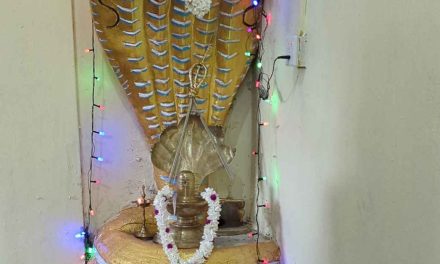Aham Brahmasmi is a Sanskrit phrase that means “I am Brahman” or “I am the absolute reality”. It is one of the four Mahavakyas or “great sayings” of the Upanishads, the ancient scriptures of Hinduism. The phrase is found in the Brihadaranyaka Upanishad, one of the oldest and most important Upanishads.
The Brihadaranyaka Upanishad is a dialogue between the sage Yajnavalkya and his wife Maitreyi, who asks him about the nature of Brahman, the supreme reality. Yajnavalkya explains that Brahman is the source and essence of everything in the universe, and that it is identical to the self (atman) within each individual. He says:
“This self (atman) is Brahman indeed. It consists of knowledge, mind, life, sight, hearing, earth, water, air, space, fire, desire, and absence of desire. It is also what is beyond desire and absence of desire. This self (atman) is also what is beyond hunger and thirst, sorrow and delusion, old age and death. Knowing this self (atman) as such, one becomes immortal.”
He then teaches Maitreyi a method of meditation to realize this truth. He says:
“As a person acts, so does he become. A person of good deeds becomes good; a person of evil deeds becomes evil. A person becomes pure through pure deeds; impure through impure deeds. As one’s desire is, so is one’s will. As one’s will is, so is one’s deed. As one’s deed is, so is one’s destiny.”
He then instructs her to meditate on the syllable OM as a symbol of Brahman. He says:
“OM is Brahman indeed. This syllable OM is also what is beyond past, present, and future. Everything that exists beyond these three times is also OM.”
He then concludes his teaching by declaring:
“Aham Brahmasmi” (I am Brahman).
This verse expresses the essence of the Upanishadic philosophy: that there is no difference between the self and Brahman, and that one can attain liberation by realizing this identity. It also implies that one has to transcend the limitations of the body, mind, and ego to experience this reality.
Aham Brahmasmi is a powerful affirmation of one’s true nature and potential. It is a statement of self-confidence and self-realization. It is a mantra that can inspire and transform one’s life.
The Essence of Aham Brahmasmi:
“Aham Brahmasmi” is a profound declaration that translates to “I am Brahman.” To truly grasp its significance, one must first understand the terms involved. Brahman, in the context of Hindu philosophy, refers to the ultimate reality, the cosmic consciousness that underlies and pervades all existence. “Aham” means “I” or “self.” When combined, “Aham Brahmasmi” signifies the realization that the individual self is not separate from the universal consciousness; it is an intrinsic part of the divine essence that encompasses everything.
The Shift in Perception:
The journey of spiritual awakening often involves a shift in perception – a transformation from seeing oneself as a limited, isolated entity to recognizing the interconnectedness and unity that exist in all things. “Aham Brahmasmi” marks this shift. It challenges the conventional notion of a separate self and invites us to see beyond the boundaries of the ego.
Breaking the Illusion of Separation:
In our everyday lives, we often operate under the assumption that we are distinct individuals, separate from others and the world around us. This perceived separation gives rise to desires, attachments, and conflicts. “Aham Brahmasmi” breaks down this illusion, reminding us that our true nature is not confined to the physical body or the individual personality. We are, in fact, manifestations of the same cosmic consciousness that flows through every being and every atom.
The Universality of the Message:
While “Aham Brahmasmi” originates from the Brihadaranyaka Upanishad, its message transcends religious and cultural boundaries. The concept of realizing oneness with the divine reality is echoed in various spiritual traditions around the world. It aligns with the Christian idea of being made in the image of God, the Buddhist concept of interconnectedness, and the Sufi notion of the divine presence within.
The Path to Self-Realization:
Realizing the truth of “Aham Brahmasmi” requires deep introspection and inner exploration. It involves peeling away the layers of conditioning, beliefs, and identifications that have accumulated over time. Through practices like meditation, self-inquiry, and mindfulness, individuals can gradually come to experience the profound unity that “Aham Brahmasmi” speaks of.
Overcoming the Ego:
The ego, often characterized as the sense of “I” or “me,” is a construct that reinforces the illusion of separation. “Aham Brahmasmi” challenges the ego’s dominance by reminding us that our true self is not limited by it. As we align our awareness with the realization that we are part of the greater whole, the ego’s grip on our consciousness loosens, allowing us to experience a sense of liberation and expansion.
Living in Alignment:
The understanding of “Aham Brahmasmi” has practical implications for how we navigate the world. When we recognize the divinity within ourselves and others, our actions naturally become more compassionate, empathetic, and harmonious. We treat others as extensions of our own self, fostering a sense of unity and shared purpose.
Aham Brahmasmi as a Mantra:
Mantras are sacred sounds or phrases that are repeated to aid in meditation and spiritual practice. “Aham Brahmasmi” is not only a profound philosophical statement but also a potent mantra. By meditating upon and repeating these words, individuals can reinforce their connection to the universal consciousness and deepen their understanding of their inherent divinity.
Conclusion:
In the grand tapestry of the Brihadaranyaka Upanishad, “Aham Brahmasmi” shines as a radiant thread that weaves together the fabric of self-realization and cosmic unity. It encapsulates the essence of spiritual awakening – the realization that the individual self is not separate from the ultimate reality. As we embrace the profound message of “Aham Brahmasmi,” we embark on a journey of self-discovery that leads us to a deeper understanding of our interconnectedness with all of existence.





